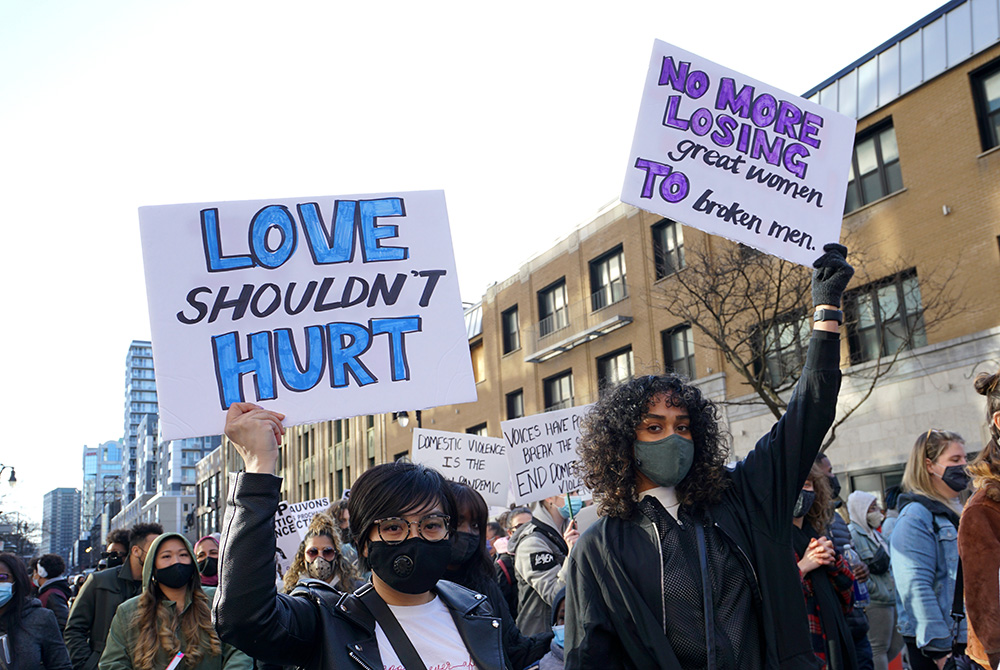How can we make real headway on the issue of gender-based violence in Canada? It’s a complex question, but a new roadmap funded by the department of Women and Gender Equality and developed by Women’s Shelters Canada aims to provide holistic answers.
“Canada is at crossroads when it comes to violence against women and gender-based violence: a perfect storm of colliding pandemics,” the report reads, a nod to the fact that COVID-19 heightened the risk of gender-based violence and contributed to a consistent rise in domestic violence reports.
To develop the roadmap, Women’s Shelters Canada brought on over 40 experts, advocates and survivors from across the country, ensuring the report was inclusive of violence against all women.
It found those most affected by violence include “people living in rural and remote areas, Indigenous people, Black people, people with disabilities, racialized people, non-binary and trans people, LGBTQI2S+ people, and migrant people.”
Its 100 recommendations centre around four pillars: prevention; support for survivors and their families; promotion of responsive legal and justice systems; and building social infrastructure. A fifth pillar on Indigenous women’s leadership is currently being developed by the WAGE Indigenous Women’s Circle, with the upcoming action plan on missing and murdered Indigenous women and girls in mind.
The recommendations range from the predictable, such as providing better funding for women’s shelters, to the more expansive: ensuring safe and reliable public transport, improving access to housing, recognizing that child care is a critical social infrastructure and more.
Pamela Cross, co-chair of the roadmap’s committee for justice and legal systems, says that one goal of the roadmap was to move away from the “band-aid” approach often used with gender-based violence: a particular issue makes its way into the spotlight, and a quick-fix solution is applied. Instead, the authors wanted to analyze why gender-based violence is so systemic.
“It was very important for us to say that this is a systemic problem. And so it needs systemic answers,” said Anuradha Dugal, executive director of the Canadian Women’s Foundation and co-chair of the working group on prevention.
Angela Marie MacDougall, executive director of Battered Women’s Support Services in B.C. and co-chair of the working group on support for survivors and their families, echoed that it was important to the team to be intersectional from the start, not just in a footnote.
“We’re talking about rural survivors, we’re talking about immigrant refugee survivors, and of course, we’re talking about Indigenous and Black survivors, as well as survivors of colour,” MacDougall explained, adding that disability is a huge factor as well.
The recommendations reflect this approach: one is to ensure uniform coverage across Canada for gender-affirming surgeries and other medical care for trans people; another is to work against anti-Black racism, including sustainable funding to Black community-based organizations and equity for Black-owned businesses.
The team delivered the report to the federal government at the end of April. The 2021 federal budget, which came out in May, earmarked $601.3 million over five years towards the issue, including funding to create a secretariat — a permanent administrative office — that will lead the co-ordination of the action plan. This total includes $200 million over two years to enhance the capacity of sexual assault centres and women’s shelters.
The commitment shown so far has been promising, Dugal said, but it will require billions, not millions, to make headway on all the recommendations.
According to WAGE spokesperson Natalie Huneault, the feedback the ministry has received has underscored the need to get the process right and ensure a strong foundation for the National Action Plan. Its development, she said, will continue throughout 2021.
“The Government of Canada is pleased that many of the report recommendations are consistent with the work done to date on the National Action Plan,” Huneault added.
Cross, whose working group’s recommendations included educating every member of the justice system on gender-based violence and ensuring every survivor has access to legal representation or a survivor advocate, says the response to the roadmap so far bodes well.
“This is a 10-year plan that requires significant attention, commitment and investment, every single year, of those 10 years,” said Cross. “If that was there, I think we actually could achieve the goals of this roadmap.”
Advocates have pushed for a national action plan for almost a decade. In 2012, the United Nations asked all national governments to develop a plan to address gender-based violence. In 2013, Women’s Shelters Canada introduced their case for a national action plan, a call they reissued in 2015 and 2020.
Given a history of sluggish response, advocates are quick to point out that accountability will be crucial to the success of this roadmap and the eventual national action plan.
The report emphasizes the need for independent oversight to hold the government accountable to implementing change — not just the secretariat, but a team completely outside of the government. It proposes a monitoring, evaluation, accountability and learning framework modelled after Australia’s response to gender-based violence.
“Independent oversight gives the National Action Plan its best chance at strategic, long-term success. And it has to be established from the start, with community-based anti-violence expertise at the table,” the introduction to the report reads.
Each recommendation names a proposed timeframe, the applicable government stakeholder and some considerations for outcome measurement. The report also emphasizes an often-used phrase from advocates that originated with South African disability rights activists in the 1980s: “Nothing about us without us.”
“The federal government has a responsibility to keep those experts who have that experience in the process all the way through the 10 years and listen to what they have to say about what’s working and what’s not working,” said Dugal.
Data from 2020 has confirmed what many already suspected — that over the course of the pandemic there has been a significant uptick in gender-based violence in Canada. According to a report published by the Canadian Femicide Observatory, 160 women were violently killed last year, up from 146 in 2019. About one in five women killed by men are Indigenous women. Trans women are routinely left out of or undercounted in data collection efforts, but they make up a disproportionate number of victims, too.
The pandemic may have prompted renewed action on the issue, but it can’t slow down now, Cross said.
“There’s no time to waste here,” she said. “Women die because of gender-based violence. Children die. Communities are destroyed by it.” ![]()
Read more: Rights + Justice, Gender + Sexuality
















Tyee Commenting Guidelines
Comments that violate guidelines risk being deleted, and violations may result in a temporary or permanent user ban. Maintain the spirit of good conversation to stay in the discussion.
*Please note The Tyee is not a forum for spreading misinformation about COVID-19, denying its existence or minimizing its risk to public health.
Do:
Do not: